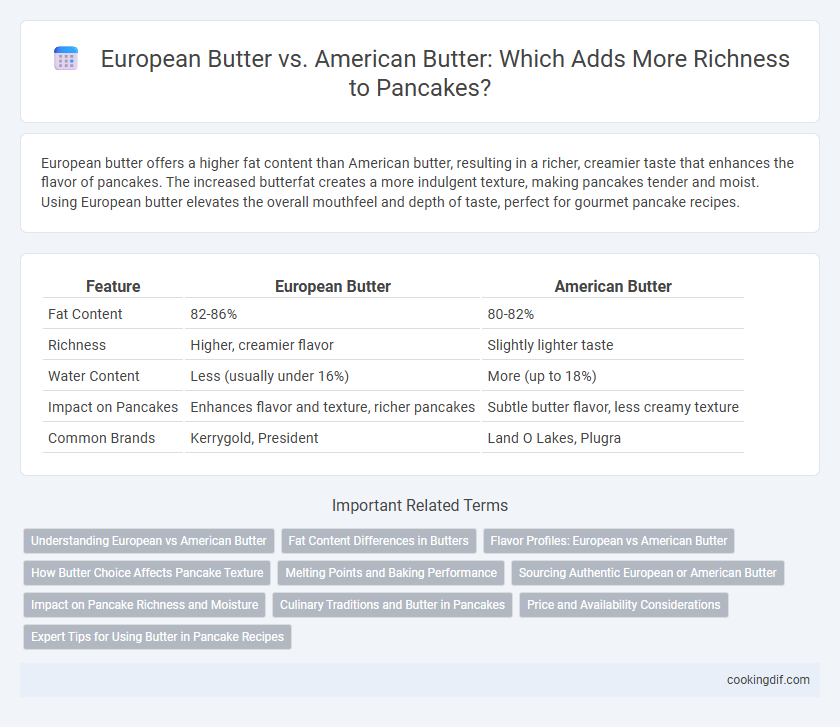European butter offers a higher fat content than American butter, resulting in a richer, creamier taste that enhances the flavor of pancakes. The increased butterfat creates a more indulgent texture, making pancakes tender and moist. Using European butter elevates the overall mouthfeel and depth of taste, perfect for gourmet pancake recipes.
Table of Comparison
| Feature | European Butter | American Butter |
|---|---|---|
| Fat Content | 82-86% | 80-82% |
| Richness | Higher, creamier flavor | Slightly lighter taste |
| Water Content | Less (usually under 16%) | More (up to 18%) |
| Impact on Pancakes | Enhances flavor and texture, richer pancakes | Subtle butter flavor, less creamy texture |
| Common Brands | Kerrygold, President | Land O Lakes, Plugra |
Understanding European vs American Butter
European butter contains a higher butterfat content, typically around 82-86%, compared to American butter's 80%, resulting in a richer, creamier texture ideal for pancakes. The culturing process used in many European butters also adds a tangy flavor that enhances pancake depth and complexity. American butter is often sweeter and less dense, which can produce lighter pancakes but with less richness and mouthfeel.
Fat Content Differences in Butters
European butter typically contains between 82% to 86% milk fat, contributing to its richer and creamier texture ideal for enhancing pancake flavor. American butter usually has a lower fat content, around 80%, which results in a less intense buttery taste and lighter mouthfeel. These fat content differences affect the moistness and overall richness of pancakes, with European butter producing more indulgent and flavorful results.
Flavor Profiles: European vs American Butter
European butter, with its higher butterfat content ranging from 82% to 86%, delivers a richer, creamier texture and a pronounced tangy, cultured flavor that enhances pancake richness. American butter typically contains around 80% butterfat, offering a milder, sweeter taste that provides a subtle buttery flavor without overpowering the pancake's softness. The distinct culturing process of European butter, often fermented, contributes complex nutty and slightly acidic notes, creating a deeper, more indulgent flavor profile compared to the neutral sweetness of American butter.
How Butter Choice Affects Pancake Texture
European butter, with its higher butterfat content (typically 82-85%), enhances pancake texture by creating a richer, creamier batter that results in tender and fluffy pancakes. American butter, usually containing about 80% butterfat, produces a slightly lighter and less moist texture, which can lead to pancakes that are less rich but still flavorful. Choosing European butter increases moisture retention and buttery flavor, significantly improving the mouthfeel and overall softness of pancakes.
Melting Points and Baking Performance
European butter typically has a higher fat content (82-86%) compared to American butter (80-82%), contributing to greater richness in pancakes. The lower melting point of European butter, around 90degF (32degC), allows for smoother incorporation and a silkier texture in batter, enhancing moisture and flavor retention during baking. This melting behavior improves the rise and tenderness of pancakes, making European butter preferable for achieving a richer, fluffier result.
Sourcing Authentic European or American Butter
Sourcing authentic European butter, known for its higher fat content and creamy texture, enhances pancake richness by delivering a luxurious mouthfeel and deeper flavor profile. American butter, with a slightly lower butterfat percentage and a sweeter, milder taste, creates lighter pancakes but offers less intense creaminess. Selecting genuine European or American butter from trusted dairies ensures optimal pancake taste and texture tailored to regional flavor preferences.
Impact on Pancake Richness and Moisture
European butter typically contains 82-86% butterfat, significantly higher than American butter's average of 80%, which directly enhances pancake richness and moisture. The increased butterfat in European butter contributes to a creamier texture and more tender crumb in pancakes, intensifying flavor depth. Using European butter results in pancakes with superior moistness and a more satisfying mouthfeel compared to those made with American butter.
Culinary Traditions and Butter in Pancakes
European butter typically contains higher fat content, around 82-85%, compared to American butter's 80%, which enhances the richness and flavor of pancakes. Culinary traditions in Europe often emphasize the use of this creamier butter, resulting in pancakes with a more luxurious texture and deeper taste. The slight tang from cultured European butter also complements the sweetness in pancakes, elevating the overall sensory experience.
Price and Availability Considerations
European butter, known for its higher fat content and rich flavor, typically commands a higher price due to artisanal production methods and import costs in the U.S. American butter, more widely available and affordable, offers moderate richness suitable for everyday pancake recipes. Consumers prioritizing indulgence may prefer European butter despite the premium, while budget-conscious shoppers often choose American butter for its accessibility and value.
Expert Tips for Using Butter in Pancake Recipes
European butter, with its higher butterfat content of around 82-86%, delivers a richer and creamier flavor ideal for pancake recipes seeking indulgence. American butter typically contains about 80% butterfat, offering a milder taste and lighter texture that can make pancakes fluffier but less rich. Expert tips recommend using European butter to enhance moisture and depth in pancakes, while American butter is preferred for achieving tenderness and ease of mixing in batter.
European butter vs American butter for richness Infographic

 cookingdif.com
cookingdif.com